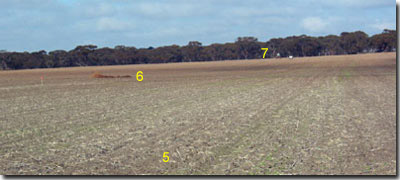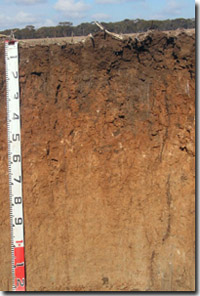ORZC6
| Location: Reedy Dam | Australian Soil Classification: Vertic (& Epihypersodic), Pedal, Calcic CALCAROSOL |
| Geology: Quaternary (Woorinen Formation). | General Landscape Description: Gently undulating plain. |
| Site Description: Ploughed cropping paddock. | Native Vegetation: Mallee. |
 Site ORZC6 Landscape |
Soil Profile Morphology:
Surface Soil
| Ap | 0-12 cm | Dark brown (7.5YR3/2); light clay; weak coarse blocky structure; weak consistence (moist); very slightly calcareous; soft surface condition with surface flake; pH 7.6; abrupt change to: |  Site ORZC6 Profile |
| Subsoil | |||
| B21 | 12-30 cm | Reddish yellow (5YR6/6); medium heavy clay; moderate very coarse to coarse prismatic, parting to strong coarse to medium blocky structure; strong consistence (dry); highly calcareous; pH 9.0; clear change to: | |
| B22 | 30-50 cm | Reddish yellow (5YR6/6); medium heavy clay; moderate very coarse to coarse prismatic, parting to moderate coarse blocky structure; strong consistence (dry); few (5%) fine earth carbonates; pH 9.3; clear change to: | |
| B23k | 50-70 cm | Reddish yellow (7.5YR6/6); light medium clay; weak to moderate coarse blocky structure; strong consistence (dry); fine earth carbonates common (10-15%); pH 9.6; gradual change to: | |
| B24 | 70-100 cm | Light red (2.5YR7/6) with few yellowish red (5YR5/8) mottles; light medium clay; weak to moderate very coarse prismatic, parting to moderate coarse blocky structure; very firm consistence (dry); pH 9.7; gradual change to: | |
| B25 | 100-130 cm | Pinkish brown (7.5YR7/4) with yellowish red (5YR5/6) mottles common; medium clay; firm consistence (dry); pH 9.7. | |
Key Profile Features:
- Calcareous throughout the soil profile.
Soil Profile Characteristics:
pH | Salinity Rating | |||
Surface (Ap horizon) | Slightly Alkaline | Low | Non-Sodic | None1 |
Upper subsoil (12-30 cm) | Strongly Alkaline | Low | Non-Sodic | None |
Deeper subsoil (at 50-70 cm) | Very Strongly Alkaline | Low | Strongly Sodic | Strong |
Deeper subsoil (at 100-130 cm) | Extremely Alkaline | Medium | Strongly Sodic | None2 |
 |
Horizon | Horizon Depth (cm) | pH (water) | pH (CaCl2) | EC 1:5 | NaCl % | Boron mg/kg | Exchangeable Cations | Field Capacity pF 2.5 | Wilting Point pF 4.2 | Coarse Sand (0.2- 2 mm) | Fine Sand (0.02-0.2 mm) | Silt (0.002-0.02 mm) | Clay (<0.002 mm) | |||
Ca | Mg | K | Na | |||||||||||||
meq/100g | ||||||||||||||||
Ap | 0-12 | 7.6 | 7.1 | 0.24 | 2.5 | 15 | 5.9 | 1.7 | 0.99 | 23 | 12 | 37 | 24 | 10 | 27 | |
B21 | 12-30 | 9.0 | 8.3 | 0.42 | <0.01 | 6.3 | 13 | 5.7 | 1.6 | 0.8 | 38 | 20 | 30 | 14 | 4 | 46 |
B22 | 30-50 | 9.3 | 8.5 | 0.55 | 0.02 | 16 | 8.3 | 15 | 1.0 | 5.9 | 43 | 23 | 24 | 14 | 7 | 48 |
B23k | 50-70 | 9.6 | 8.7 | 0.64 | 0.04 | 24 | 4.5 | 15 | 1.1 | 7.6 | 42 | 22 | 23 | 15 | 4 | 44 |
B24 | 70-100 | 9.7 | 8.8 | 0.84 | 0.07 | 24 | 3.3 | 14 | 1.3 | 9.6 | 42 | 20 | 25 | 16 | 4 | 41 |
B25 | 100-130 | 9.7 | 8.7 | 0.89 | 0.08 | 21 | 3.3 | 12 | 1.2 | 9.1 | ||||||
Management Considerations:
Whole Profile
- In general, management strategies for all soils should aim to increase organic matter levels in the surface soil, minimise the degradation of soil aggregates and porosity, promote the development of stable biopores, improve the calcium status of the ion exchange complex (particularly when sodium is a significant part) and break up any hardpans. Less frequent tillage, using less aggressive implements and working the soil at optimum moisture conditions can all assist in maintaining soil aggregation and porosity, as well as, reducing the breakdown of organic matter.
- The surface soil is non-sodic but disperses moderately after remoulding. This indicates that structural degradation (e.g. surface sealing, increased cloddiness) may occur if the soil is cultivated or overstocked in a moist to wet condition. Also, raindrop action on bare soil may also promote dispersion and result in surface sealing or surface crust formation. Surface cover should be maintained to protect against raindrop damage. The use of gypsum may also assist in ameliorating the surface soil.
- The surface soil is well suited as a seedbed – the surface condition is soft and the soil has a weak consistence (i.e. it does not become excessively hard). However, it is quite shallow and should be protected as much as possible from wind and water erosion and over-cultivation. Promoting organic matter levels would be beneficial.
- The subsoil is strongly to extremely alkaline. This indicates that some nutrients (e.g. iron, manganese, zinc, copper) may be poorly available to plants and that deficiencies are likely to occur. Deficiencies should be determined by plant tissue analysis.
- Boron toxicity can also occur in strongly alkaline soils. Boron levels increase in the very strongly alkaline subsoil (from 30 cm depth) to levels which may affect the growth of boron-sensitive species including cereals, pulses, pasture legumes. Concentrations as low as 10 ppm, for example, can reduce lentil yield. Although there is limited data it is estimated that the threshold level of soluble boron for cereals is 15 mg/kg (Cartwright et al., 1984). Other work at VIDA indicates that where there are low levels of soluble salts boron tolerance can be comparatively high, with little reduction in wheat yield at levels of up to 45 ppm (Quinlan, 2001).
- The level of soluble salts becomes medium at 70 cm depth. This may restrict the growth of deeper-rooted salt-sensitive species.
References:
Cartwright, B., Zarcinas, B.A, and Mayfield, A.H. (1984). Toxic concentrations of boron in a red-brown earth at Gladstone, South Australia. Australian Journal of Soil Research. 22. 261-72.
Hobson, K. (2001). Boron Tolerant Lentils. In On The Pulse pamphlet. NRE. 2001.
Quinlan, J. (2001). Sorting out the Boron Problem. Wimmera Farming & Landcare Newsletter. 19-20.
Rengasamy, P. and Churchman, G.J. (1999). Cation Exchange Capacity, Exchangeable Cations and Sodicity. In: Soil Analysis – An Interpretation Manual. (eds. Peverill, K.I et al). CSIRO Publishing.


